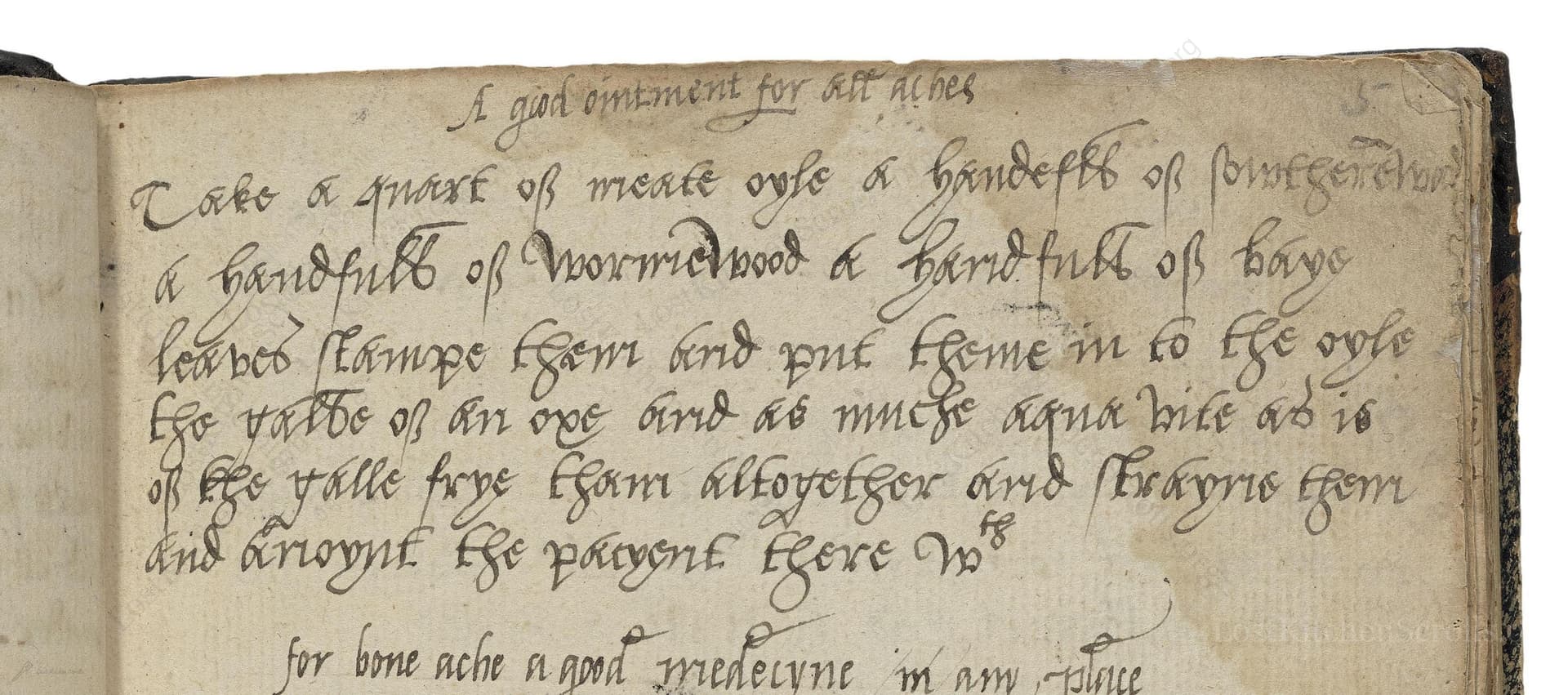A Good Ointment For All Aches
From the treasured pages of Miscellany by a family in Ledbury, Herefordshire
Unknown Author

A Good Ointment For All Aches
"Take a quart of meate oyle & a handfull of sowergerchom a handfull of wormwood & a handfull of baye leaves stampe them and put them in to the oyle the value of an oxe and as muche aqua vite as is of the value frye them altogeather and strayne them and anoynt the pacyent there with"
Note on the Original Text
This recipe is written in early modern English, with spellings like 'oyntment', 'meate oyle', 'aqua vite', and 'anoynt' that differ from today’s conventions. The language is direct, combining both instructions ('stampe them and put them in to the oyle') and quantities (using approximate 'handfulls'). The phrase 'the value of an oxe' is ambiguous; here, it seems to imply adding as much aqua vitae as there are herbs by bulk. Recipes in this era often mix medicine and cookery in their method and tone, relying on the reader’s practical experience rather than precise measurement.

Title
Miscellany by a family in Ledbury, Herefordshire (1570)
You can also click the book image above to peruse the original tome
Writer
Unknown
Era
1570
Publisher
Unknown
Background
Step into the kitchens of the late Renaissance with this delightful historical culinary book, brimming with secrets, flavors, and recipes from the sixteenth century. Perfect for curious cooks eager to time travel via their taste buds.
Kindly made available by
Folger Shakespeare Library
This recipe hails from mid-to-late 16th century England (circa 1550-1590), a time when medicine and cookery were closely linked. Households often relied on their own preparations for everything from injuries to illnesses, using available local herbs and imported ingredients like olive oil and aqua vitae—luxuries for many, but present in well-off homes. The blend of ingredients reflects Renaissance beliefs in balancing humors and warding off ‘bad airs’ with powerful botanicals. Recorded in a manuscript simply labeled 'E.a.1', this remedy represents the fusion of folk traditions with the era’s growing fascination for alchemy and the practical knowledge passed from household to household.

Back in the Tudor period, such ointments would be concocted over the open hearth in a heavy cauldron or pan—usually of copper or iron. Herbs would be crushed with a pestle and mortar, then steeped in oil and spirit while gently heated over the coals. The mixture would be strained through linen or muslin, and stored in glazed earthenware jars. Measurements were imprecise, often dictated by a trusting hand and a practiced eye.
Prep Time
10 mins
Cook Time
30 mins
Servings
10
We've done our best to adapt this historical recipe for modern kitchens, but some details may still need refinement. We warmly welcome feedback from fellow cooks and culinary historians — your insights support the entire community!
Ingredients
- 1 quart olive oil (or other good quality meat-based/fatty oil, traditionally used in the past)
- 1 oz fresh sorrel (substitute: gromwell or similar tangy green herbs)
- 1 oz fresh wormwood leaves
- 1 oz fresh bay leaves
- 3.5 fl oz aqua vitae (substitute: brandy, unflavored schnapps, or strong neutral spirit, 40% ABV or higher)
Instructions
- To create this soothing ointment in a modern kitchen, begin by measuring out 1 quart of olive oil (the historical 'meate oyle').
- Gather roughly 1 ounce each (about one large handful) of sorrel (as a stand-in for 'sowergerchom', which likely refers to sorrel or perhaps gromwell), wormwood leaves, and bay leaves.
- Chop or crush all of the leaves coarsely to help release their essences.
- Place the olive oil in a heavy-bottomed saucepan.
- Add your prepared herbs.
- The reference to 'the value of an oxe' and 'as much aqua vite as is of the value' is cryptic; it suggests using a quantity of 'aqua vite' (a strong distilled spirit, like brandy or unflavored schnapps) equal to the volume of the herbs, which would be approximately 3.5 fluid ounces.
- Pour this into the saucepan too.
- Gently heat the mixture, allowing it to fry just below a simmer for 20-30 minutes.
- Stir frequently and do not let it boil.
- Once fragrant and the leaves look wilted and infused, strain through a fine cloth or sieve into a clean container.
- Allow it to cool before applying as a topical ointment.
Estimated Calories
900 per serving
Cooking Estimates
It takes about 10 minutes to prepare the herbs and measure everything. Cooking (infusing) the ointment takes 30 minutes. This recipe makes about 10 servings, with each serving being about 100 ml. Each serving has around 900 calories because of the olive oil, which is most of the mixture.
As noted above, we have made our best effort to translate and adapt this historical recipe for modern kitchens, taking into account ingredients nowadays, cooking techniques, measurements, and so on. However, historical recipes often contain assumptions that require interpretation.
We'd love for anyone to help improve these adaptations. Community contributions are highly welcome. If you have suggestions, corrections, or cooking tips based on your experience with this recipe, please share them below.
Join the Discussion
Rate This Recipe
Dietary Preference
Main Ingredients
Culinary Technique
Occasions

Den Bockfisch In Einer Fleisch Suppen Zu Kochen
This recipe hails from a German manuscript cookbook compiled in 1696, a time whe...

Die Grieß Nudlen Zumachen
This recipe comes from a rather mysterious manuscript cookbook, penned anonymous...

Ein Boudain
This recipe comes from an anonymous German-language manuscript cookbook from 169...

Ein Gesaltzen Citroni
This recipe, dating from 1696, comes from an extensive anonymous German cookbook...
Browse our complete collection of time-honored recipes



